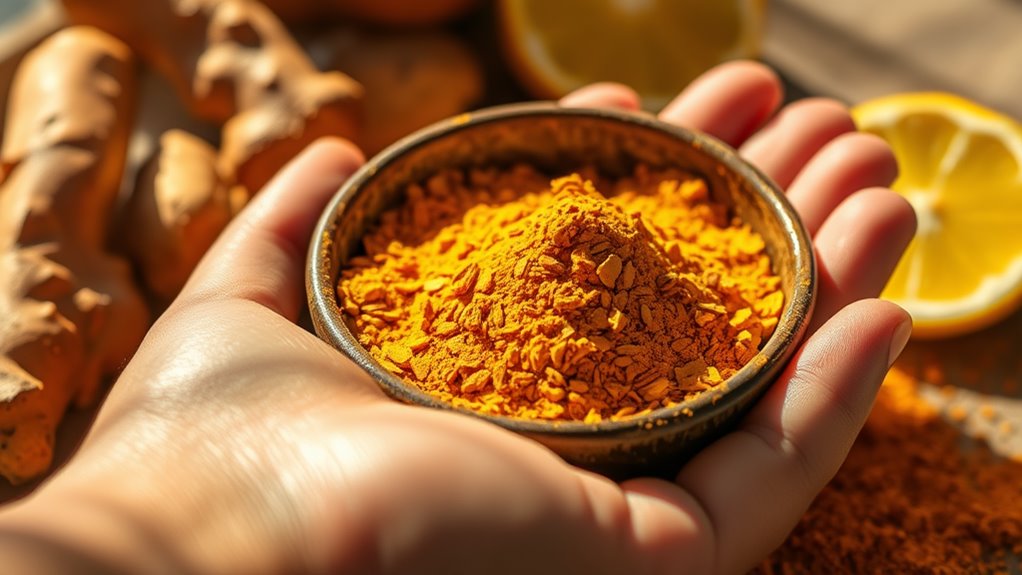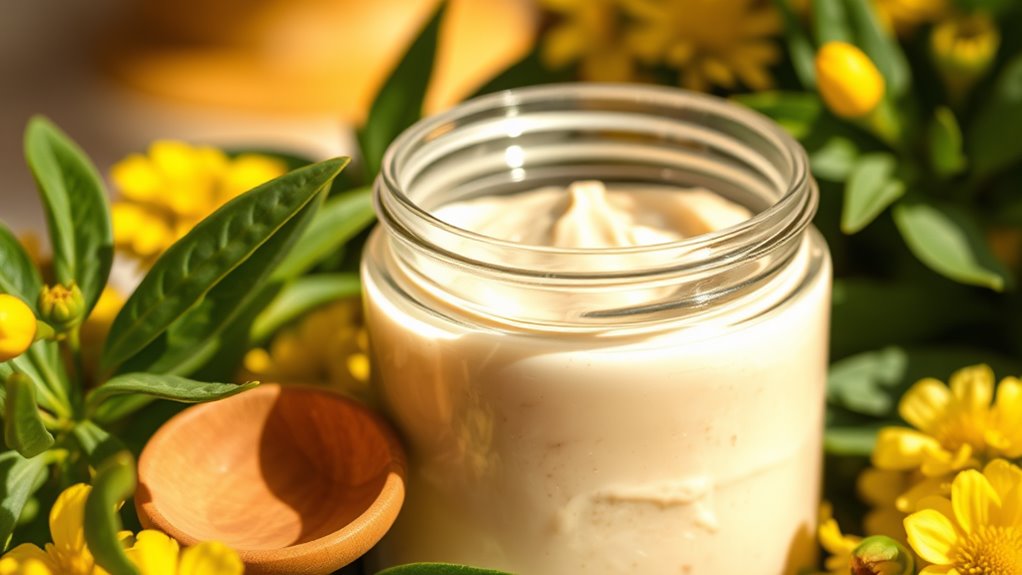Turmeric Hacks for Clear and Bright Skin
Turmeric’s amazing for achieving clear and bright skin! Its anti-inflammatory and antimicrobial properties help combat acne and reduce scarring. You can whip up a simple face mask using one tablespoon of turmeric and two tablespoons of yogurt for a hydrating boost. Pairing it with honey enhances antibacterial effects. Just remember to patch test first and avoid any stains. Stick around to discover more tips and tricks for incorporating this powerhouse into your skincare routine!
Key Takeaways
- Mix turmeric with yogurt for a hydrating mask that brightens skin and reduces redness.
- Combine turmeric and honey to enhance antibacterial benefits and combat acne effectively.
- Create a turmeric-infused oil with a carrier oil for nourishing post-cleansing skin treatment.
- Incorporate lemon juice with turmeric to boost brightness and even out skin tone.
- Use turmeric soap or cleanser daily for consistent skin health benefits and a clearer complexion.
Benefits of Turmeric for Skin Health
When it comes to skincare, turmeric stands out as a powerhouse ingredient that offers numerous benefits for your skin health. This golden spice is renowned for its anti-inflammatory properties, helping to reduce redness and irritation.
By incorporating turmeric beauty into your routine, you can combat acne and diminish the appearance of scars and dark spots. Its antioxidant-rich composition fights free radicals, promoting a youthful glow.
You’ll also find that turmeric can balance oil production, making it ideal for both dry and oily skin types. Additionally, its antimicrobial effects help fight off bacteria, contributing to a clearer complexion. Research has shown that turmeric’s active compound, curcumin, enhances skin health by reducing inflammation and promoting healing.
Leveraging turmeric’s potent benefits empowers you to achieve the radiant, healthy skin you desire. Embrace this natural wonder for a transformative skincare experience.
DIY Turmeric Face Masks for Radiant Skin
Creating your own turmeric face masks can be a game changer for achieving radiant skin.
Start with a simple blend of turmeric and yogurt; this combination brightens your complexion and hydrates your skin. Mix one tablespoon of turmeric powder with two tablespoons of plain yogurt. Apply it evenly to your face and let it sit for 15 minutes before rinsing off.
For an extra boost, add honey for its antibacterial properties.
Another effective mask uses turmeric and coconut oil; mix a teaspoon of turmeric with a tablespoon of melted coconut oil. This mask nourishes and helps combat dryness.
Always do a patch test first to avoid any reactions. Additionally, incorporating natural ingredients like honey and avocado can further enhance your skin’s appearance and health.
Embrace these DIY masks, and watch your skin transform into a radiant masterpiece!
How to Incorporate Turmeric Into Your Skincare Routine
Incorporating turmeric into your skincare routine is easier than you might think, and it can lead to noticeable improvements in your skin’s health.
Start by adding turmeric powder to your favorite face mask or moisturizer. Just mix a small amount with honey or yogurt for a powerful, brightening treatment.
You can also create a turmeric-infused oil by mixing it with a carrier oil, like coconut or jojoba. Apply this oil after cleansing for a nourishing boost.
For targeted treatment, try a turmeric spot treatment on blemishes. Also, consider using turmeric soap or cleanser to reap benefits daily.
Consistency is key—make turmeric a regular part of your routine for lasting results, and your skin will thank you.
Precautions and Tips for Using Turmeric
While turmeric can be a fantastic addition to your skincare routine, it’s important to take some precautions to secure the best results.
First, always conduct a patch test before applying turmeric to your skin. This helps you avoid any allergic reactions.
Second, remember that turmeric can stain, so wear old clothes and use gloves when handling it.
If you’re using turmeric masks, limit application to once or twice a week to prevent irritation.
Also, consider mixing turmeric with a carrier like yogurt or honey to enhance its benefits and reduce potential sensitivity.
Finally, if you have pre-existing skin conditions, consult a dermatologist before incorporating turmeric into your regimen. Additionally, using turmeric in combination with other ingredients can target acne scarring effectively and provide even better results.
Mastering these tips secures a safe and effective experience with turmeric.
Additional Ingredients to Pair With Turmeric for Enhanced Results
To maximize the benefits of turmeric in your skincare routine, consider pairing it with other powerful ingredients that enhance its effects. Honey is a fantastic companion; its natural antibacterial properties complement turmeric’s healing abilities, promoting clear skin.
For a brightening boost, mix turmeric with vitamin C-rich lemon juice, which can help even out your skin tone. Aloe vera is another excellent addition, offering soothing hydration that balances turmeric’s potency.
Finally, blend turmeric with yogurt, as its lactic acid gently exfoliates while delivering moisture. By combining these ingredients, you’ll create a potent skincare regimen that harnesses the full power of turmeric, leading to visibly brighter and clearer skin. Additionally, using natural oils in your routine can further enhance hydration and combat signs of aging.
Experiment with these combinations to find what works best for you.
Frequently Asked Questions
Can Turmeric Stain My Skin Permanently?
Turmeric can temporarily stain your skin, especially if used in high concentrations. However, it typically fades within a few hours or days. Regular cleansing can help remove any residual color, ensuring your skin stays clear.
Is Turmeric Safe for All Skin Types?
Turmeric’s generally safe for most skin types, but you should always patch test first. If you have sensitive skin, you might experience irritation. Listen to your skin’s response, and adjust your usage accordingly for best results.
How Often Should I Use Turmeric on My Skin?
You should use turmeric on your skin 1-2 times a week. This frequency helps maintain balance, allowing your skin to reap its benefits without risking irritation. Adjust based on your skin’s response for best results.
Can I Use Turmeric if I Have Sensitive Skin?
If you have sensitive skin, you can still use turmeric, but start slowly. Test a small area first, and consider mixing it with soothing ingredients like yogurt or honey to minimize irritation while enjoying its benefits.
What Should I Do if I Experience a Reaction to Turmeric?
If you experience a reaction to turmeric, stop using it immediately. Rinse the area with cool water, apply a soothing cream, and monitor for improvement. If symptoms persist, consult a healthcare professional for advice.





